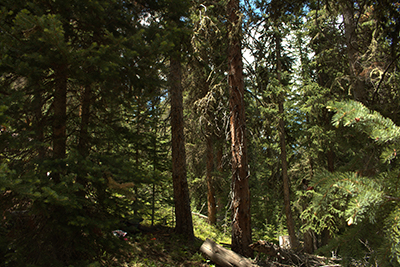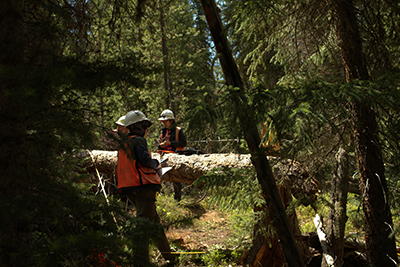RESISTANCE:
Maintain relatively unchanged conditions over time
General DFC statement: The goal of this treatment is to maintain the current conditions such as species composition and general stand structure as possible, while reducing the site's tree density. This includes retaining the species composition (except for mature Abies lasiocarpa (subalpine fir)), surface fuels and snags, and disturbance regimes for high-elevation spruce-fir forests

Management Goals:
- Build resistance to windthrow, beetles, and drought by limiting tree mortality
- Reducing stand density can reduce the physical stress on tress which can then help build resistance to windthrow, drought, and beetles
- Promote tree vigor and release, increase wind firmness, and remove dead trees
- Provide ecosystem services, including wood products, watershed health, recreation opportunities, carbon sequestration potential, and cultural resources
- Provide lynx habitat (need some large trees)
- Maintain aesthetics / recreation value
Strategies & Approaches:
- Mechanical thinning to remove dead trees, trees with mistletoe, and some green trees
- Release cut to reduce stand density and encourage advance regeneration
- Alter species proportions through favoring healthy spruce and lodgepole
- Create surface fuels for soil moisture retention and surface roughness (20-35 tons/acre)
- Maintenance of snags for wildlife use by keeping at least 4/acre ≥ 10 inches DBH for Picea engelmannii (Engelmann spruce) and subalpine fir, or ≥ 8 inches DBH for Pinus contorta (lodgepole pine)
RESILIENCE:
Allow some change in current conditions, but encourage eventual return to original conditions
DFC Statement: The goal of this treatment is to begin promoting some future adapted species that already present on-site but are currently at low densities, while promoting Engelmann spruce and lodgepole pine over subalpine fir. The stand density will be reduced by removing ladder fuels; however, some snags and surface fuels will be left on site to promote wildlife habitat. The treatments will accommodate a disturbance frequency of 70-120 years to help promote species diversity and overall ecosystem resilience to wildfire, insects, diseases, and forest pests.
Management Goals:
- Build resilience to drought, fire, white pine blister rust, windthrow, bark beetles
- Promote future-adapted native tree species and genotypes (drought) to create multiple ways for vegetation development
- Promote lodgepole pine for serotiny (fire resilience)
- Promote rust-resistant Pinus flexilis (limber pine) genetics
- Retain genotypes on site (refugia-like)
- Create a heterogeneous structure and reduce fuels in the matrix
- Promote wildlife habitat by retaining large diameter trees and snags
- Provide ecosystem services, including wood products, watershed health, recreation opportunities, and cultural resources
- Create opportunities for carbon sequestration by retaining larger trees
Strategies & Approaches:

- Group selection to encourage lodgepole regeneration
- Remove 20-30% of the basal area creating 3 2-acre groups and 3 1/2-acre groups
- Place groups near overstory lodgepole pine to facilitate natural regeneration
- Generally thin the matrix to promote healthier stands
- Overall reduce the stand density by 10-20%
- Remove Engelmann spruce <10” dbh, while maintaining mature/live spruce
- Remove subalpine fir across all size classes >5” dbh
- Keep lodgepole pine and any Populus tremuloides (quaking aspen) present
- Passively allow any natural regeneration to establish within matrix
- Favor aspen and lodgepole pine in open areas
- Plant Douglas-fir (local source) and rust-resistant limber pine
- Maintain snags to help promote wildlife
- Minimum of 4 snags/acre, retained in larger clumps if possible
- Wildlife supported: boreal owls, lynx snowshoe hares, boreal toad, elk, deer
- Reduce ladder fuel build-up while leaving some to promote roughness, soil moisture, and nutrient cycling
- Lop and scatter (20-35 tons/acre) to encourage lodgepole pine height growth and seedling survival during drought years. Allow for regeneration of spruce
TRANSITION:
Actively facilitate change to encourage adaptive responses
DFC Statement: The goal of this treatment is to transition the forest composition to future adapted species and promote a heterogenous forest structure in age and fuel type. Snags and surface fuels will be reduced more than in the other treatments to create an open understory and reduce fire intensity. Shrubs, however, will be promoted to help wildlife. Finally, treatments will aim for disturbance regimes of 30-50 years through lower surface fuel loads and tree densities that promote fire and drought-adapted species.
Management Goals:
- Create firebreaks, break up dense forest to limit insect outbreaks, and promote natural regeneration opportunities to create heterogenous forest structure
- Favor future-adapted species that tolerate variable environmental conditions/disturbances (temperature extremes, drought, mixed-severity fire, insects, etc)
- Create a variety of regeneration microsites
- focus on topography and drier/wetter microsites (i.e. topographic wetness index; heat load index), CWD/slash retention
- Increase wind firmness
- Reduce surface fuels to be appropriate for an upper montane-mixed conifer forest (10-20 tons/ac)
- Increase shrub component for wildlife habitat
- Provide ecosystem services, including wood products, watershed health, recreation opportunities, and cultural resources
- Create opportunities for carbon sequestration through large tree retention
Strategies & Approaches:
- Group selection: create an overstory mosaic through gaps and thinning

The Colorado Forest Restoration Institute crew collecting pre-treatment data at the ASCC research sites. Photo Credit: Angelika Helmer - Create one large 4-acre opening and multiple small 1/2-acre gaps within thinned matrix
- Lower residual density
- Remove subalpine fir and Engelmann spruce to create 0.25-acre gaps for planting in matrix
- Keep lodgepole pine and large trees in matrix
- Promote quaking aspen if already growing, especially in moist topographic areas
- Weed around remaining trees and maintain open areas with brush cutter, creating structures from upper montane mixed-conifer forests
- Allow any natural regeneration
- Details of tree species composition to be planted: Plant future adapted species with a different seed source than resilience treatment
- Details of spacing grid for planting:
- Douglas Fir 40%; Ponderosa pine 30%; limber/Pinus aristata (bristlecone pine) 20%; Picea pungens (blue spruce) 10%
- Plant Douglas-fir across the site in gaps and matrix
- Plant ponderosa pine in the drier microsites within the gaps
- Plant limber pine across the site in gaps, matrix, and ridgetops
- Plant some bristlecone pine because it is more blister rust resistant than limber pine
- Plant blue spruce on wetter microsites within matrix
- Retain snags and keep large snags in clumps to help windfirm the area and create wildlife habitat
- Minimum number of 4 snags/acre
- Plant shrubs such as Mountain Ash, Rocky Mountain Maple, Mountain Mahogany, Bitterbrush, and Ceanothus shrubs in persistent tree-less openings
- Reduce surface fuels to promote surface roughness, moisture retention, and nutrient cycling
- Whole trees will be harvested
- Fuels will be reduced to 10-20 tons/acre


